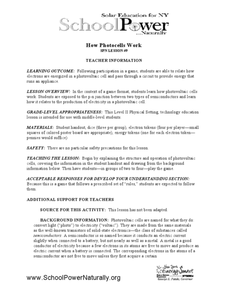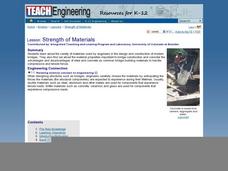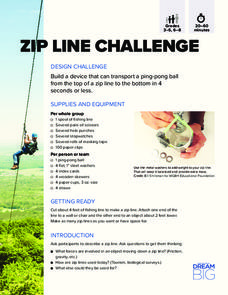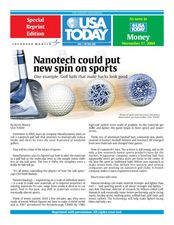Curated OER
Metals and Hydrogen Cars: Chemistry 10-12
Students investigate which metal is best to use as storage material in hydrogen cars. In this chemistry lesson, students differentiate endothermic and exothermic reactions. They write a reflection paragraph about what they learned in the...
Curated OER
The BEAM Project: Building Efficient Architectural Models
Technology or engineering teams are given a task to design, construct, and test the efficiency of a structure that will foster an even temperature throughout an entire sunny day. Intended as a long-term project, pupils research, plan,...
Teach Engineering
Alloy Advantage
Mix it up by using an intriguing resource that teaches young metallurgists that alloys are a metal mixture. They learn about the advantages of using alloys over pure metals and investigate titanium alloys as an example to finish the...
Teach Engineering
Solenoids
Metal slinkies, coils of wire, magnetic fields, and MRIs. To determine the safety hazards of MRI machines, class members use the provided formula to calculate the magnetic field along the axis of the solenoid.
Teach Engineering
Magnetic Materials
The design challenge: develop a method to separate steel from aluminum. The first lesson plan in an eight-part series introduces the class to the grand challenge of ciming up with a method to streamline a sorting process at a...
National Sailing Hall of Fame
Introduction to Sailboats
The left part of the boat is called what? An informative lesson plan and accompanying slideshow presentation introduce middle schoolers to the terminology and parts associated with a sailboat.
Curated OER
How Photocells Work
Give small groups of physical scientists tokens that represent electrons in a photovoltaic cell. They play a dice game in which they move the tokens around, representing the flow of electrons through the p-n junction of a semiconductor...
Intel
Prototyping
I need something to test. The three sessions in this lesson have individuals build and test a prototype of their design. The first two sessions are devoted to prepping for the prototype by drawing up specifications and materials. The...
Teach Engineering
Magnetic or Not?
The class must determine the magnetic properties of different materials, including aluminum and steel by sorting through materials using a magnet. Groups make a prediction on whether a material is magnetic and then perform...
Teach Engineering
Electricity and Magnetic Fields
Introduce your class to the idea of magnetic fields around electrical wires with an activity that provides the information about the direction of a magnetic field around a wire carrying an electric current.
Teach Engineering
Slinkies as Solenoids
What does an MRI machine have to do with a slinky? This activity challenges learners to run a current through a slinky and use a magnetic field sensor to measure the magnetic field. Groups then change the length of the slinky to see...
Teach Engineering
Alloy the Way to Mars
Future engineers test different alloys to determine the specific strength of each one. Based on the results, they make a recommendation to NASA on which alloy to use on engines for spacecraft.
Teach Engineering
Bend That Bar
Bend it, but don't break it. Groups investigate the strength of different materials. Using a procedure in the seventh segment of a 22-part series on aviation, pupils determine how far a rod will bend. They determine the strength-to-mass...
Teach Engineering
Strength of Materials
Pupils examine a stress-strain diagram that compares the advantages and disadvantages of the two common bridge building materials, concrete and steel. The also consider the factors that influence the materials builders choose for their...
Teach Engineering
Understanding Elements
Nothing says organization quite like a table. The third lesson in a six-part Mixtures and Solutions unit teaches young scientists about elements and the periodic table. They learn how the periodic table is organized and about the...
Teach Engineering
Gumdrop Atoms
There's nothing sticky about the resource, unless you count the gumdrops! Scholars create a model of a lithium atom, complete with protons, neutrons, and electrons. It's just that these models are made with gumdrops and toothpicks.
Teach Engineering
Drawing Magnetic Fields
Class members use a compass and several points to map out the magnetic field of a magnet. Pairs trace the magnetic field lines produced by a permanent magnet by positioning the compass in numerous spots around the magnet to view the...
Teach Engineering
Building an Electromagnet
Your pupils can build their own electromagnet — awesome! The culminating activity in an eight-part series challenges groups to design and build their own electromagnet. The goal of the activity is to build a magnet capable of picking up...
DiscoverE
Zip Line Challenge
Harness the awesome power of gravity. Scholars build a zip line to transport a ping-pong ball. The challenge is to get to the finish line in under four seconds. At that speed, individuals better be sure to strap on the harness!
Curated OER
Concrete Lesson Plan
Students describe the difference between cement and concrete. In this technology lesson, students explain the mixing process of concrete. They discuss its importance in the modern world.
Curated OER
Indians in Georgia
Students investigate technology used by Native Americans by examining their creations. In this Native American math lesson, students examine the overall area of Mississippian Indian mounds that were built hundreds of years ago....
Curated OER
Nanotech Could Put New Spin on Sports
Twelfth graders study the concept of nanotechnology. In this Modern Technology instructional activity, 12th graders read an article about the upcoming Nanotechnology. Students create an enhanced sports product.
Teach Engineering
Electromagnets
Show your class what goes on with a magnet that can be turned on and off with a resource that provides the information needed to build an electromagnet. The information allows the class to understand that creating loops with the current...
Curated OER
Hunt the Fact Monster September #2
In this internet research learning exercise, 3rd graders use the Fact Monster search engine to find the answers to five multiple choice questions. A sample question asks: "Which ocean borders the African country of Ghana?"























